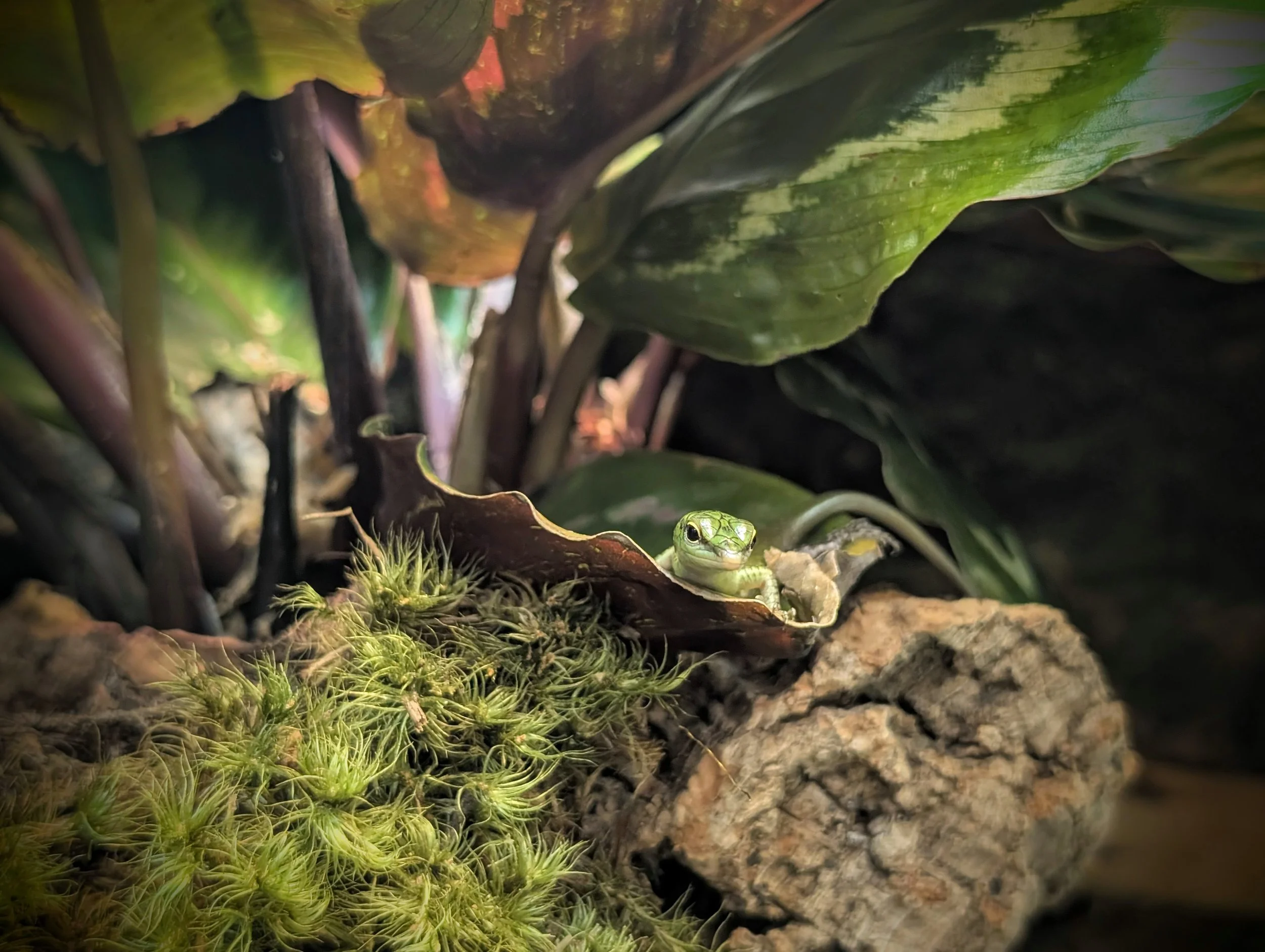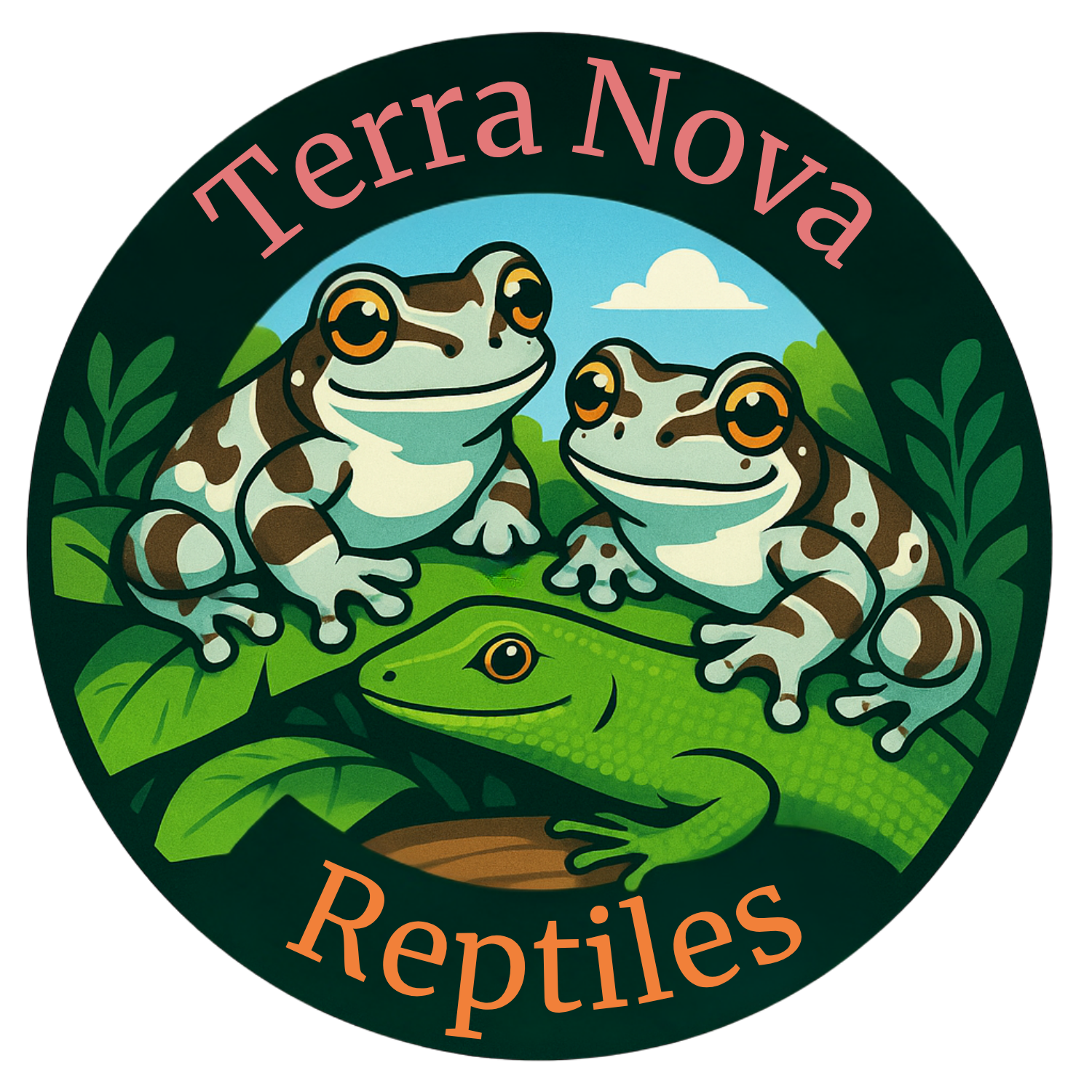
The Amazing Emerald Tree Skink
-

General Information
Learn more about this incredible little lizard!
-

Care Guide
Find out what Emerald Tree Skinks need to be happy & healthy!
-

Our Breeding Program
Thinking of getting an Emerald Tree Skink?
What is an Emerald Tree Skink?
Emerald Tree Skinks (Lamprolepis smaragdina)
The Emerald Tree Skink is a vibrant and agile lizard native to Southeast Asia and the Pacific Islands. Named for its striking green coloration, this arboreal species is known for its sleek body, long tail, and curious, intelligent behavior. Adults typically reach 8–10 inches in length, with slender limbs and sharp claws well-adapted for climbing.
These skinks inhabit tropical forests and coastal areas, where they spend most of their time in trees, basking in sunlight or foraging for insects and fruit. In captivity, they thrive in vertically oriented enclosures with plenty of branches, foliage, and hiding spots that mimic their natural environment.
Emerald Tree Skinks are highly active and social reptiles that can display fascinating behaviors, especially when housed in groups (ideally with proper space and monitoring). While they may be a bit shy at first, with consistent handling and a calm environment, they can become quite interactive and bold.
Known for their intelligence and speed, Emerald Tree Skinks require a well-maintained environment with warm temperatures, high humidity, and UVB lighting to stay healthy. Their diet should include a variety of live insects, supplemented with occasional fruits and calcium/vitamin dusting.
With their dazzling appearance and energetic personality, Emerald Tree Skinks make rewarding pets for intermediate to experienced reptile keepers who are prepared to meet their environmental and behavioral needs.
Emerald Tree Skink Care Guide!
🔹 BASIC OVERVIEW
Scientific Name: Lamprolepis smaragdina
Common Name: Emerald Tree Skink
Adult Size: 8–10 inches (including tail)
Lifespan: 7–12 years (in captivity with proper care)
Temperament: Alert, active, can become tame with regular interaction
Difficulty: Intermediate
🏠 ENCLOSURE
Size
Minimum: 18x18x36" (for one adult)
Ideal: 24x18x36" or larger (especially for a pair or trio)
Type: Vertical space is essential — use tall, front-opening enclosures like Exo Terra or Zoo Med.
Material
Glass or PVC enclosures are ideal for humidity retention and visibility.
Substrate
Best Options:
Coconut fiber (Eco Earth)
Reptisoil
Organic topsoil mixed with sphagnum moss
Depth: at least 2–4 inches to allow burrowing and maintain humidity
Spot-clean: Daily
Full replacement: Every 1–2 months unless you are going with a bioactive setup
Furnishings
Branches and vines for climbing (critical)
Vertical cork bark or bamboo
Live or fake plants (pothos, philodendron, bromeliads)
Leaf litter for enrichment and hiding
Hide spots at different heights
🌡️ TEMPERATURE & LIGHTING
Temperature Gradient
Basking spot: 90–95°F (32–35°C)
Ambient/daytime: 75–85°F (24–29°C)
Nighttime: Can drop to 70–75°F (21–24°C)
Use an overhead basking bulb; avoid heat rocks.
Lighting
UVB Required: Yes (they are diurnal and benefit from UVB)
Use a 5.0 UVB bulb (T5 HO preferred) across half the enclosure.
Provide 12 hours of light per day.
Humidity
Optimal range: 60–80%
Mist 1–2x daily or use an automatic misting system
Ensure good airflow to prevent mold and respiratory issues
🥬 DIET
Type
Omnivorous — mainly insectivorous, but some plant/fruit matter is appreciated.
Staples
Crickets
Dubia roaches
Silkworms
Mealworms (in moderation)
Black soldier fly larvae
Occasional
Waxworms (treats only)
Soft fruits: papaya, mango, banana, berries (small amounts)
Repashy or Pangea crested gecko diet (fruit mixes)
Supplements
Calcium with D3: 2–3 times/week
Calcium without D3: Lightly at most feedings
Multivitamin: Once a week
💧 WATER & HYDRATION
Provide a shallow water dish or running water feature
Misting also allows them to drink from leaves
Monitor hydration — wrinkled skin or sunken eyes may indicate dehydration
🦎 HANDLING & BEHAVIOR
Temperament: Fast, alert, intelligent — not aggressive but shy at first
Handling Tips:
Avoid grabbing from above (predator-like behavior)
Use slow, gentle movements
Hand-feed to build trust
With time, they can become very interactive and even curious about their keeper
🧬 SEXING & BREEDING
Males: Slightly larger, broader heads, sometimes visible femoral pores once mature
Females: More slender
Breeding:
Can be bred in captivity
Females lay small clutches (1–2 eggs)
Provide moist hide or laying box if not using a bioactive habitat
Incubate at 80–84°F (27–29°C); hatch in ~60–70 days
🧼 MAINTENANCE & HEALTH
Daily
Check temperature and humidity
Spot-clean waste
Observe for any signs of stress or illness
Clean water dish unless you have a running water feature
Weekly
Deep misting or fogging
Inspect plants and branches
Common Health Issues
Dehydration: Prevent with proper humidity and misting
Nutritional deficiencies: Use supplements and a varied diet
Parasites: Wild-caught individuals especially prone — quarantine and vet check recommended
Mouth rot, skin infections: Watch for swelling, discolored patches
✅ TIPS FOR SUCCESS
Provide lots of vertical climbing space and dense foliage
Avoid overhandling early on; build trust slowly
Keep day/night cycle consistent
Always gut-load feeder insects
Use bioactive setups if possible for easier maintenance and enrichment
Our Emerald Tree Skink Breeding Program
Where Ethics Meet Excellence
At Terra Nova Reptiles, we are proud to run one of the few ethical, captive-bred Emerald Tree Skink (Lamprolepis smaragdina) programs in the country. Our mission is simple: to promote responsible reptile keeping, reduce pressure on wild populations, and offer healthy, socialized skinks to passionate keepers and conservation-minded individuals.
We believe education is key to responsible reptile keeping. Visit our Care Guide page for everything you need to know about housing, feeding, and handling Emerald Tree Skinks.
For direct inquiries or setup consultations, feel free to Contact Us — we’re always happy to help.
-
Emerald Tree Skinks are still commonly imported from the wild, often under stressful conditions that compromise their health and contribute to habitat depletion. We believe in a better way forward.
By breeding this species responsibly in captivity, we:
Protect wild populations from overharvesting
Ensure skinks are acclimated to life in human care
Deliver animals with stronger immune systems and stable temperaments
Promote education, conservation, and species appreciation
-
We focus on small-scale, high-quality breeding with a deep respect for animal welfare.
✅ Selective Pairing
We carefully select breeding pairs based on health, temperament, and genetic diversity. Our skinks are never line-bred or overbred, ensuring robust and healthy offspring.
✅ Spacious, Enriched Environments
Each breeding group is housed in large, naturalistic enclosures with:
Live plants and climbing structures
Natural substrate and leaf litter
Vertical space for true arboreal behaviors
UVB and full-spectrum lighting
Controlled temperature and humidity zones
This setup allows skinks to express natural behaviors such as basking, climbing, digging, and even courtship displays — all signs of well-being.
✅ Bioactive Setups
All enclosures are bioactive, supporting sustainability and reducing stress on the animals. Clean-up crews (isopods and springtails) help maintain cleanliness naturally.
✅ Ethical Egg Collection
We provide nesting sites that mimic the skinks' wild laying preferences. Eggs are gently collected and incubated in controlled conditions that ensure high hatch rates and healthy neonates.
-
Emerald Tree Skink hatchlings are raised in small-group enclosures to promote safety and reduce competition. From the moment they hatch, our skinks are:
Fed a varied, gut-loaded insect diet with appropriate supplementation
Exposed to UVB and basking cycles
Hand-fed and gently interacted with to build trust
Monitored closely for growth, development, and behavior
We do not rush the process. Only when a skink is strong, active, and well-adjusted do we make it available for adoption or sale.
-
We never sell to mass distributors, flippers, or chain pet stores. Our skinks go only to experienced keepers or those willing to learn and commit to high standards of care. We offer:
Pre-purchase screening to ensure appropriate setups
Lifetime support for every skink we place
Educational resources, care guides, and setup consultations
-
We actively collaborate with educators, zoos, and conservation groups to raise awareness of Emerald Tree Skinks and their ecosystems. A portion of our proceeds supports:
Reptile rescue and rehab
Habitat preservation projects in Southeast Asia and the Pacific Islands
Local school and outreach programs that promote responsible herpetoculture
-
We have options for shipping in Canada, the US and Europe. Please note that we only use courier services with a proven track record of safe live-animal handling. All shipping is done at purchasers expense.
Live Arrival Guarantee included
Local pickup is welcome by appointment
To view current availability or get on our waiting list, click here.










